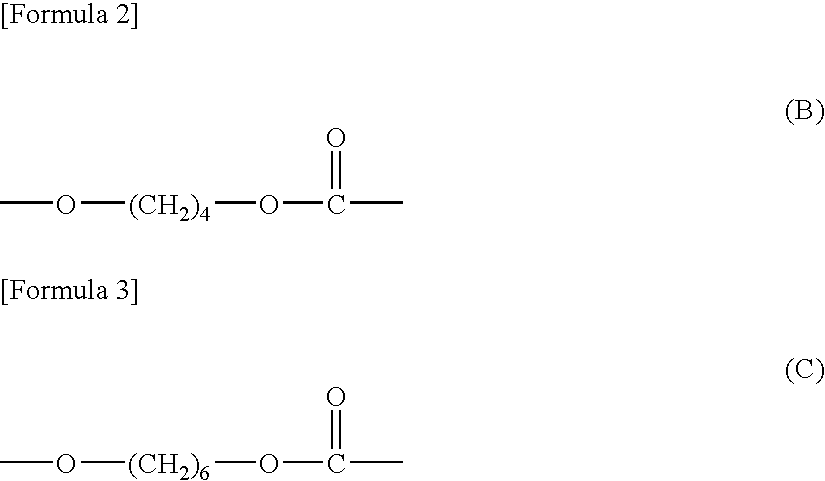Polycarbonate diol
- Summary
- Abstract
- Description
- Claims
- Application Information
AI Technical Summary
Benefits of technology
Problems solved by technology
Method used
Image
Examples
example 1
[0072]In a 1-L glass flask equipped with a rectifying tube filled with structured packings and a stirrer, 280 g (3.1 mol) of dimethyl carbonate, 200 g (2.2 mol) of 1,4-butanediol and 120 g (1.0 mol) of 1,6-hexanediol were placed. As a catalyst, 0.10 g of titanium tetrabutoxide was added thereto, and the mixture was stirred and heated at ordinary pressure. The reaction was performed for 10 hours while the reaction temperature was gradually raised from 150° C. to 180° C. and while a mixture of produced methanol and dimethyl carbonate was being distilled out. Thereafter, the pressure was reduced to 17 kPa and the reaction was performed at 180° C. further for 7 hours while the mixture of methanol and dimethyl carbonate was being distilled out. The analysis results of the obtained polycarbonate diol are summarized in Table 1.
example 2
[0075]The polymerization was performed using the apparatus indicated in Example 1. In the apparatus, 420 g (3.6 mol) of diethyl carbonate, 200 g (2.2 mol) of 1,4-butanediol and 120 g (1.0 mol) of 1,6-hexanediol were placed. As a catalyst, 0.09 g of titanium tetrabutoxide was added thereto, and the mixture was stirred and heated at ordinary pressure. The reaction was performed for 10 hours while the reaction temperature was gradually raised from 150° C. to 180° C. and while a mixture of produced ethanol and diethyl carbonate was being distilled out. Thereafter, the pressure was reduced to 18 kPa and the reaction was performed at 180° C. further for 7 hours while the mixture of ethanol and diethyl carbonate was being distilled out. The analysis results of the obtained polycarbonate diol are summarized in Table 1.
example 3
[0076]The polymerization was performed using the apparatus indicated in Example 1. In the apparatus, 320 g (3.6 mol) of ethylene carbonate, 250 g (2.8 mol) of 1,4-butanediol and 100 g (0.9 mol) of 1,6-hexanediol were placed. As a catalyst, 0.12 g of titanium tetrabutoxide was added thereto, and the mixture was stirred and heated at ordinary pressure. The reaction was performed for 10 hours while the reaction temperature was gradually raised from 150° C. to 180° C. and while a mixture of produced ethylene glycol and ethylene carbonate was being distilled out. Thereafter, the pressure was reduced to 15 kPa and the reaction was performed at 180° C. further for 7 hours while the mixture of diol and ethylene carbonate was being distilled out. The analysis results of the obtained polycarbonate diol are summarized in Table 1.
PUM
| Property | Measurement | Unit |
|---|---|---|
| Fraction | aaaaa | aaaaa |
| Fraction | aaaaa | aaaaa |
| Ratio | aaaaa | aaaaa |
Abstract
Description
Claims
Application Information
 Login to View More
Login to View More - R&D
- Intellectual Property
- Life Sciences
- Materials
- Tech Scout
- Unparalleled Data Quality
- Higher Quality Content
- 60% Fewer Hallucinations
Browse by: Latest US Patents, China's latest patents, Technical Efficacy Thesaurus, Application Domain, Technology Topic, Popular Technical Reports.
© 2025 PatSnap. All rights reserved.Legal|Privacy policy|Modern Slavery Act Transparency Statement|Sitemap|About US| Contact US: help@patsnap.com



